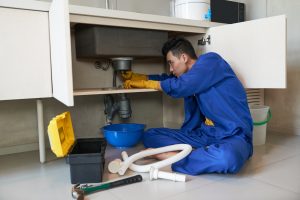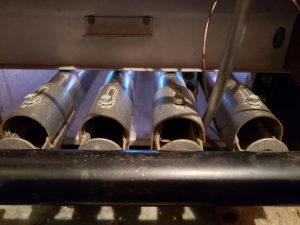Building traps sometimes referred to as sewer traps or sanitary traps, were common on properties before the 1950s. They were to prevent sewer gases from backing up into a home from the main drain.
Have you seen cute little metal mushroom caps in front yards all over the neighbourhood? Some are painted; some are blended in with the landscaping. Others are smack in the middle of the driveway, waiting to be driven over and damaged. Have you ever wondered what was hiding beneath the surface? Just below the tell-tale domed cover lays a major catastrophe waiting to happen…
What does a building trap do?
The open pipe protected by that round cover is a breather or vent for what is called a building trap. A building trap is a U-shaped bend in the main sewer drain as it leaves your home. The purpose of this trap was to hold, or “trap” water and create a barrier between the putrid methane atmosphere of your city’s sewage system and your home. Back before the 1950s, this was a very common way of protecting homes from smelly sewers.
Today modern plumbing code requires that every single plumbing fixture needs to have its own trap. This is usually known as the “U-bend” or “P-trap”. They are installed in easy-to-access areas whenever possible and many can be disassembled for easy cleaning of debris and blockages. This means that the building trap is now no longer required. Many of the homes on your street have had them removed already. Now, in place of the metal cap, there will be either one or two clean-out access covers to allow for easy maintenance with a drain-clearing machine.
Why should I be concerned?
It was realized before too long that these older building traps are very problematic. They are difficult to keep clear, and just like the trap under your kitchen sink, it occasionally becomes plugged. However, instead of just having a blocked sink, you have a blocked house. The first sign of a problem is sewage backing up into your basement through any available opening, whether this is a floor drain, a basement shower or a toilet.
The clay pipes that these traps were originally built with are not as strong as modern plastic drainpipes. They are more prone to damage either by tree roots getting in or by collapsing in on themselves.
Of course, back in the days when these houses were built, most basements were not used for anything but storage so this would be more of a nuisance problem, but now that basements have become a primary living area, what would have been a minor annoyance is now a major headache and many thousands of dollars in insurance claims.
What should I do if I have a building trap?
Have it removed immediately. It isn’t worth rolling the dice, and hoping that nothing will happen. It’s not a question of “IF”, it’s a question of “WHEN” it will cause a disaster. If you are unsure if your home has a building trap, contact a plumber to help you find out. Every home is different, and the location of these traps varies from region to region. Some are located in the front yard; others are under the basement floor. Plumbers and drain technicians have video cameras and locating tools that can help eliminate the guesswork.
A plumber will excavate the trap and remove it, then will install a straight piece of pipe in its place. Usually, they will also install a cleanout to allow for future maintenance of the drains. This can usually be done in a day, sometimes a bit longer depending on the circumstances.
Another device that can save you from major flooding problems is something called a “backwater valve”. This can be installed as part of your drain repair job. Many insurance companies are requiring homeowners to install these special one-way valves in order to qualify for insurance coverage from flood damage.
Your home is your biggest investment, don’t take chances. If you live in the greater Toronto area give us a call. Leaside Plumbing has skilled plumbers ready to help you. We have been in business for over 30 years and we work hard to maintain our excellent reputation.
We would be happy to provide you with an estimate for any of your plumbing or drain needs.
Learn about our waterproofing services here.
TIPS TO PROTECT YOUR HOME FROM FLOODING
- Remove the building trap if you have one
- Redirect any downspouts to spill rainwater onto the lawn or driveway to keep it out of your drain pipes
- Install a backwater valve
- Make sure that sump pumps are in good working order. Replace any pumps older than 5 years
- Install a battery backup pump to protect your sump pit from overflowing during a power outage
Sometimes despite our best efforts, we can’t protect ourselves from every possible hazard, so make sure you contact your insurance company to find out if you are covered for water damage. Coverage will vary and may include sewage only, or stormwater only.






